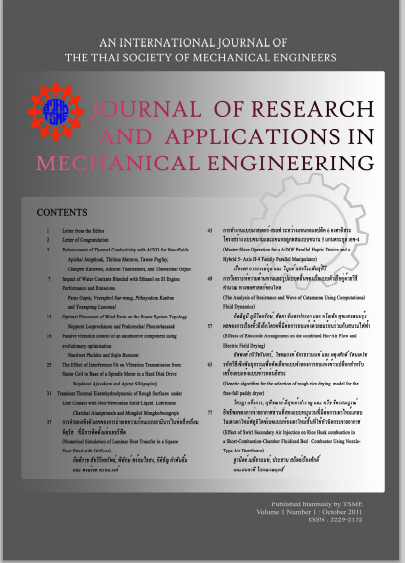H∞ Robust control via singular value decomposition as a design tool for continuous dynamic systems
Main Article Content
Abstract
We present a novel generic tool to design the shape and location of an actuator for continuous elastic dynamic systems, i.e. essential properties of the actuators in order to generate a desired state profile. The main idea of the research is to generate an approximation via reduction of the number of actuators by using the singular value decomposition (SVD). SVD is a powerful and elegant method for data analysis aimed at obtaining low-dimensional approximation of high-dimensional data. We implement our work on the structural dynamics of a clamped elastic beam. By the use of Finite Difference Method (FDM), we divide the beam into discrete elements. Each element has the ability to translate and rotate with respect to the surrounding elements. By implementing the theory of robust H control, we obtain the optimal control law with respect to the worst exogenous input. This and the use of SVD enables us to approximate efficiently the number of actuators needed. Thus, enabling us to reduce the number of actuators that are necessary in order to obtain a desirable state profile with a robust control law.
Article Details
This work is licensed under a Creative Commons Attribution-NonCommercial-ShareAlike 4.0 International License.
References
[2] Y. Qiu, "Distributed Piezoelectric Actuator with complex shape," 2002.
[3] R. L. Clark and C. R. Fuller, "Control of sound radiation with adaptive structures," Journal of Intelligent Material Systems and Structures, vol. 2, pp. 431-452, 1991.
[4] R. L. Clark and C. R. Fuller, "Experiments on active control of structurally radiated sound using multiple piezoceramic actuators," Journal of the Acoustical Society of America, vol. 91, pp. 3313-3320, 1992.
[5] R. L. Clark and D. E. Cox, "Multi-variable structural acoustic control with static compensation," Journal of the Acoustical Society of America, vol. 102, pp. 2747- 2756, 1997.
[6] C. R. Fuller, "Experiments on reduction of aircraft interior noise using active control of fuselage vibration," Journal of the Acoustical Society of America, vol. 78, pp. 1-88, 1985.
[7] C. J. Swigert and R. L. Forward, "Electronic damping of orthogonal bending modes in a cylindrical mast - theory," Journal of Spacecraft and Rockets, vol. 18, pp. 5-10, 1981.
[8] T. Bailey and J. E. Hubbard, "Distributed piezoelectric polymer active vibration control of a cantilever beam," Journal of Guidance Control and Dynamics, vol. 8, pp. 605-611, 1985.
[9] S. B. Choi, "Alleviation of Chattering in Flexible Beam Control Via Piezofilm Actuator and Sensor," AIAA Journal, vol. 33, pp. 564-567, 1995.
[10] W. T. Baumann, "An adaptive feedback approach to structural vibration suppression," Journal of Sound and Vibration, vol. 205, pp. 121-133, 1997.
[11] K. W. Eure, "Adaptive predictive feedback techniques for vibration control," Electrical Engineering, Virginia Polytechnic Institute and State University., 1998.
[12] C. Y. Chong and S. P. Kumar, "Sensor networks: evolution, opportunities, and challenges," Proceedings of the IEEE, vol. 91, pp. 1247-1256, 2003.
[13] R. S. Chandra, J. Fowler and R. D'Andrea, "Control of interconnected systems of finite spatial extent," IEEE Conference on Decision and Control, pp. 238-239, 2002.
[14] S. Burke and J. Hubbard, "Active vibration control of a simply supported beam using a spatially distributed actuator," IEEE Control Systems Magazine, vol. 7, pp. 25-30, 1987.
[15] A. Shojik and J. Yojik, "On the Singular Value Decomposition of the Yojik Phenomana," Proceedings of the IEEE Transaction Automation and Control, vol. 16, pp. 621-634, 2011.
[16] H. Versteeg and W. Malalasekera, An Introduction to Computational Fluid Dynamics, The Finite Volume Method, P. P. Hall, Ed., Essex, 1995.
[17] S. Patankar., Numerical Heat Transfer and Fluid Flow, Hemisphere, London,, 1980.
[18] P. Holmes, L. Lumley and G. Berkooz, Turbulence, coherent structures, dynamical systems and symmetry., C. monographs on Mechanics, Ed., Cambridge University Press, 1996.
[19] J. P. Cusumano, M. T. Sharkady and B. W. Kimble, "Experimental Measurements of Dimensionality and Spatial Coherence in the Dynamics of a Flexible-Beam Impact Oscillator," Philosophical Transactions of the Royal Society of London A, vol. A 347, pp. 421-438, 1994.
[20] G. Kerschen and J. C. Golinval, "Physical Interpretation of The Proper Orthogonal Modes Using The Singular Value Decomposition," Journal of Sound and Vibration, vol. 249, pp. 849-865, 2002.
[21] D. Koditschek, W. Schwind, M. Garcia and R. Full, "Cockroach posture identification using principal component analysis.," In preparation.
[22] R. Ruotolo and C. Surace, "Using SVD to Detect Damage in Structures With Different Operational Conditions," Journal of Sound and Vibration, vol. 226, pp. 425-439, 1999.
[23] C. Scherer and S. Weiland, Linear Matrix Inequalities in Control, T. Netherlands, Ed., Delft Center for Systems and Control, 2000.
[24] S. Timoshenko, History of strength of materials,, N. York, Ed., McGraw-Hill, 1953.
[25] J. Strikwerda, Finite difference schemes and partial differential equations, Society for Industrial Mathematics, 2004.



